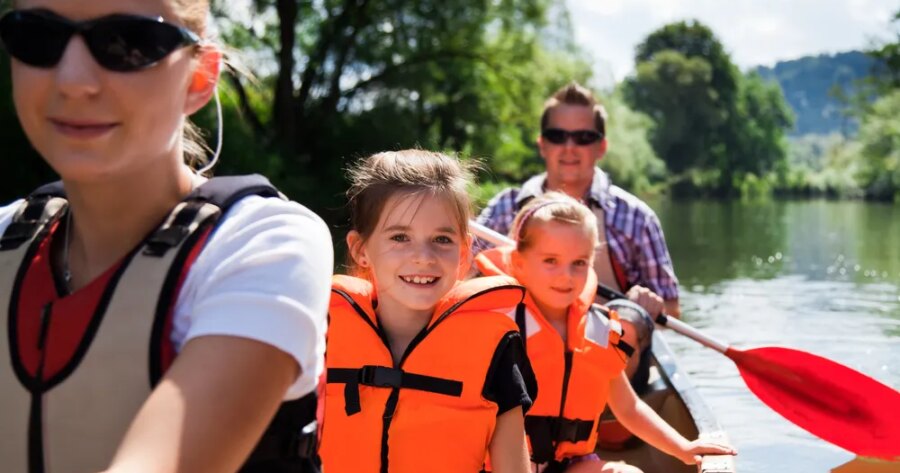So you want to take your kids in the Great Outdoors – good for you! Whether you’re a new parent or on child number three, it’s never too late to start taking your family outside. Maybe you were a seasoned solo outdoors-person before you started your family and now need some advice as you bring along your littles. Or maybe you’ve never been an outdoorsy person, but are looking for a way to get active or get out of your house as you navigate this new season of parenthood. Either way, these tips are for you!
20. Start getting them outdoors young
The easiest way to get your children to enjoy the outdoors is to get them outside when they’re young. And in many ways, getting outdoors when your child is an infant is actually the easiest time of their lives because they can’t object! If kids grow up spending time outdoors, it normalizes it and while they’re still guaranteed to complain on the trail sometimes (I mean, they are kids), there will never be this big moment of “We’re doing WHAT?!”.
19. Make time in nature a regular part of your lives
Whether it’s getting out for a weekend of tent camping or just leaving behind the car keys and stroller for an evening walk, get outside as a family as much as possible – even if you can only do 15 minutes a day! The more you do it, the less “weird” it’ll feel for you, your partner, and your kids. Plus, as you make time outdoors part of your routine you may also just find that some of the benefits start manifesting in your lives – feeling less stressed and anxious, having more energy and focus, and experiencing a greater sense of confidence!
18. Buy specialized gear
While you’re still figuring out what activities you enjoy, renting, borrowing, or repurposing gear and clothing make the most sense. For example, you won’t want to rush out and buy a high-end pair of hiking boots before you even figure out if you and your kiddo enjoy it! Instead, lace up your runners and choose lighter trails that don’t require shoes with a heavy tread. However, once you’ve figured out what you like, invest in some quality gear for your family. Mountain biking is more fun if you have a comfortable seat and a pair of proper shorts, hiking is more enjoyable if you have good hiking boots and a quality daypack, and getting out on the water to canoe or kayak is easier if … you have a watercraft. There may be clothing you can get second-hand (especially for kids!) from thrift stores or Buy and Sell groups as well, so take the time to identify what you should be looking for new versus used – especially since kids grow out of gear quickly!
17. Have an activity in mind
Whether it’s swimming, biking, hiking, canoeing, kayaking, geocaching, camping, rock climbing, or any other of the many activities you can do outdoors, have some sort of plan as to what you’re going to do together. Not only does this help you plan ahead and pack appropriately, it provides some structure and sets out expectations for your kids. Over time your kids might get used to being more “go with the flow”, but when you’re just starting to get outside, plan a specific activity. After you’re done, ask your family members what they liked and disliked about it, what was easy or challenging, and whether they’d enjoy doing it again.
16. Stay local to start
North America is absolutely bursting with incredible parks to enjoy the outdoors in, but don’t feel like you always need to drive far to enjoy nature. There may be some trails, a conservation area, or a boat launch in or just outside of your city! I love going out into the middle of nowhere, but sometimes the planning and time that goes into an adventure like that are too much. Don’t feel defeated if you feel overwhelmed at the thought of packing up all the kids and gear! Instead, take a look online to see what local trails are available to you. Any time outdoors is well spent, even if it’s only an hour or so.
15. Plan a scavenger hunt or nature BINGO
An easy way to keep kids engaged and moving on the trail is to plan a game! Nature BINGO is an easy game to prepare and it beloved by most children. Create a BINGO sheet with things they might find while outdoors: types of leaves, bug or animal species, rocks, plants, etc. or do a quick Google search to find a pre-made one. It can be made very simple for young children and more difficult and specific for older children! Either way, it’ll keep those little feet moving forward!
14. Buy a proper child carrier backpack
When your child is still a baby, a good quality wrap should do the trick on the trail. We’re big fans of the Solly Baby Wrap and Moby Baby Wrap! But once your child gets a bit older (and heavier), I can’t emphasize enough the importance of investing in a good quality child carrier backpack that will support them comfortably and allow you to carry them on hikes without strain. This will translate to you getting outside more, which is ultimately the end goal here! There are many great brands on the market, but I’d suggest visiting your local outdoor equipment store to get properly fitted because even the best carrier won’t be good enough if it’s too big or too small.
13. Go slow
When you’re getting started, make sure you choose appropriate hike/bike/etc. lengths so your kiddos don’t develop negative associates with time spent outdoors. If you’ve got a school-age child who isn’t used to spending a lot of time outdoors, start by taking a walk (around the block, to a friends house, or to the park) together a few times a week and have them point out the “nature” they see. This begins to normalize outdoors active time. After all, the only difference between a walk and a hike is the location! Another great thing to try if your child will be walking the trail themselves (not in a carrier) is child-directed hiking. This is, quite literally, when you allow your child to lead the hike – how fast you walk, how long you walk, what you stop to look at, and so on. This may seem annoying since it’s quite possible you’ll only make it 15 feet to the nearest pond where they splash around for 10 minutes, but cultivating a love for nature at a young age is a building block for longer, more strenuous outdoor activities as they get older.
12. Get them involved in planning and preparing
If your kiddo is old enough, invite them to participate in planning the outdoor activity or trip! Planning your time as a group creates buy-in and reduces the chance of the dreaded “But I don’t want to do that!” complaints later on. Kids can do research on an activity they want to try, a park they want to visit, what they might need to pack, and so on. There are meaningful ways kids can contribute at all ages, which may reduce the preparation required by you, as well as create excitement and self-confidence in your children! Plus, you can have meaningful family time together before you even get outdoors.
11. Accept that you’re not above a bribe
Okay, real talk here parents. Sometimes you need to bribe your kid. We’re not proud, but sometimes it happens. Rewarding them with candy or the promise of an ice cream or toy at the end of the activity if they’re struggling to finish that last few kilometers may help them push through. You have to remember that completing a hike may not be inherently rewarding for kids when they’re so young, so stash a couple surprise bribes in your pack to be prepared. It’s like potty training rewards all over again! Pro tip: If you’re giving them high sugar treats, make sure you time them so that they crash in the car ride home, not while still outdoors!
10. Hype the trip or excursion beforehand
Sometimes we avoid telling children about plans too far ahead of time because (if they’re excited) they will quite literally ask if “today is the day?” every single day leading up to the Big Day. However sometimes letting them in on the secret is actually a good idea! If outdoorsy-type activities are new for your kiddo, giving them time to ask lots of questions and get excited may work in your favor. Plan a project for them or go to the local library to take out books to learn more about where you’ll be going and what you’ll be doing. This may help them feel more prepared and ready to take on a new experience!
9. Invite a friend or more experienced family
There nothing wrong with asking for help! If you’re feeling overwhelmed at the thought of taking your kid(s) on a hike or camping trip, consider asking a more experienced friend to help you plan and come with you. That way, if anything goes awry (or your kiddo tests your patience a little too much), you’ll have backup! If you lack more experienced friends, grab any friend and go for an easy hike or nature walk on a flatter (perhaps slightly more urban) trail. Either way, it’ll feel easier to get outdoors when you’re not doing it alone.
8. Be prepared but not scared
Sometimes worry about what could happen to you or your kids outdoors creeps in. We get it! You love your kids and stepping into the unknown can be scary. It’s important to be prepared and mitigate unnecessary risk, so do your research ahead of time. Bringing a fully stocked first aid kit, knowing the closest hospital, wearing a life jacket, and making sure everyone drinks lots of fluids are all good ways to mitigate risk. But it’s equally important to not obsess over what could go wrong and instead remember that you don’t need to be scared. As you get outdoors more often, your confidence will grow and you’ll worry less about the “what ifs”. I promise, there’s more to be gained on the trail than off.
7. Tell your kids they can get dirty (and then don’t be upset when they do)
This may seem ridiculous because kids seem to get dirty regardless of whether you tell them they can or not. However, prefacing your excursion with a clear expectation that they don’t have to worry about being reprimanded later for getting mud and dirt on their hands and feet (and face and everywhere else) and stains on their clothes, gives them the freedom to fully relax in nature. Tell them that you want them to engage all their senses, enjoy the adventure, and explore everything (as long as they aren’t in harm’s way or disrespecting nature). And then when you’re all done and headed back indoors covered head to toe in dirt, hold your tongue and stick to your word, mama.
6. Pack simple snacks and lots of liquids
Even adults aren’t fun to be around when we’re hangry (hungry + angry), so head outdoors prepared with food, even if you’ve just had a big meal. Physical activity burns a lot of calories and in order for your child to keep moving, they will require fuel! Without fuel, the last kilometer of the trail will take forever to them to finish as they become more tired. Pack food in reusable containers or if you’re bringing prepackaged snacks (like applesauce or granola bars), remember to bring a big Ziploc bag to pack out your garbage. If you’re planning full meals (i.e. you’re doing a camping or canoe trip), opt to keep meals super simple so you can spend more time enjoying family time instead of preparing complicated recipes. And remember, pack food they like because there’s no way they’re going to magically enjoy it on the trail if they don’t eat it at home!
5. Bring a new game, toy, book, or activity
Consider bringing a new “something” on your next outdoorsy endeavor! A new car toy may help your little one stay motivated to move along the trail. Or new beach toys may be a welcome addition to playing in the sand and swimming. Or a new board game to play as a family on a camping trip may be something for your kiddo to look forward to! Having a new toy, game, book, or activity acts as both a reward and something familiar to do in an unfamiliar setting. Don’t want to spend much? Borrow or trade an old game or toy for a new one with someone you know or on a trading group on Facebook.
4. Pick one skill to teach them
If you’re going outside for a shorter activity, you may be teaching them the activity itself! However, if you’re going on a longer excursion, like a camping or canoe trip, choose a practical skill to teach them or even learn together! Skills like properly tying knots, building a fire, and setting up a tent are all great things kids can learn from a younger age. But let them pick what they want to learn! Learning skills takes some responsibility off you (once they’re confident in doing the skills by themselves), but more importantly, it develops confidence in themselves and their abilities in the outdoors. I’d also encourage you to teach all your children the same skills, regardless of gender. Though it’s rarely done with malintent, boys tend to be taught outdoors skills by their dads and grandfathers, while girls are not given the opportunity to learn these skills that are more traditionally associated as being masculine. Break those gender roles and make sure all your kiddos know important outdoor skills!
3. Join a family-friendly outdoors group
Yes, these groups exist! Need somewhere to start? Check out Hike It Baby to find your city and the next local hike. They’re a group of inclusive families committed to raising a generation who love the outdoors and they have chapters all over the United States, Canada, and abroad! In the meantime, check out their Instagram for some major inspiration.
2. Get connected online
In the age of technology, it’s easy to find people who challenge, inspire, and share interests (and maybe some fears too) with you. If you’re feeling intimidated about getting outdoors with kids, check out some of blogs and Instagram accounts for inspiration and practical advice. Some of my favorites blogs include Raising Kids Wild, Adventure Mamas Initiative, and The Outdoor Dad. Also check out Melody Forsyth (@downwithadventure) and Shanti Hodges (@hikingmyway) on Instagram for an encouraging and inclusive space for moms and dads!
1. Remember it’s worth it
At first, it may seem daunting and difficult to get outside with kids, but I promise it gets easier over time and with practice. Remember that it’s worth the effort! Spending time outdoors has a long list of benefits for your child (and you!) including lower risk of disease; increased creativity, confidence, energy, and focus; and decreased levels of anxiety, depression, and stress. Your children will thank you one day for fostering a love for the outdoors and may even be inspired to do it with their families too (if they choose to have one)! You can do it, mom and dad!























